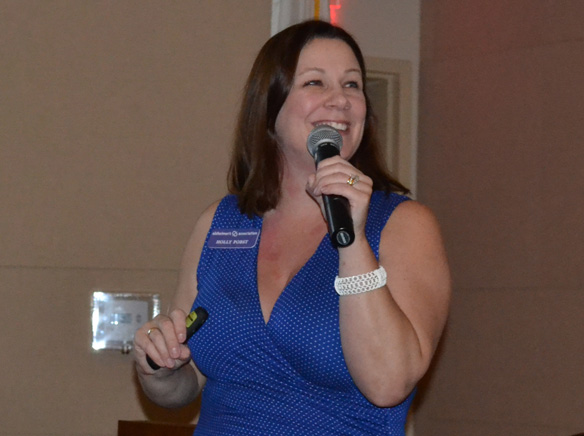One out of eight people age 65 and over will develop Alzheimer’s disease. By age 85, one out of two people will have Alzheimer’s. It’s not just the disease and symptomatic dementia that is so terrible for aging persons and their loved ones, it’s the fallout associated with the disease – managing risks, providing care, and learning to separate the person from the disease. As the baby boomers age in what is referred to as the “Silver Epidemic”, dementia and Alzheimer’s are increasing in the 65+ population, requiring assistance for not just the afflicted, but also their caregivers. That is where the Alzheimer’s Association of San Diego comes in.
The San Diego Alzheimer’s Association held a lecture at Grossmont’s Healthcare District Conference Center in La Mesa on Thursday, January 9th to share information for those dealing with Alzheimer’s. Holly Pobst, Community Education Manager for the Alzheimer’s Association’s San Diego Chapter, lectured for two hours to a large crowd eager for answers on coping with the debilitating disease. The audience took notes, raised their hands with questions, and nodded their heads in solemn agreement when Pobst presented on screen the hallmark signs of dementia. Most were surprised to learn that Alzheimer’s is the third leading cause of death in San Diego County.
“People with Alzheimer’s will aspirate, come down with pneumonia, or they forget how to swallow,” Pobst explained. Because dementia is what Pobst described as “a cognitive loss severe enough to interfere with daily life that starts in the part of the brain that houses short-term memory,” the things that well-functioning adults have done with ease become challenging until they can no longer be accomplished alone, necessitating round-the-clock help. Seventy percent of the time when dementia is present, Alzheimer’s is the cause.
In the early stages of Alzheimer’s dementia, people with the disease are still fairly independent. The middle stage of the disease is the longest stage, and by late stage Alzheimer’s, hands-on assistance is imperative. A progressive degenerative disease of the brain, Alzheimer’s can last from three to twenty years after on set, with eight being the average.
In addition to memory loss, people with dementia setting in wander without apparent intention, fixate on things, or start “shadowing” other people. “Do people with dementia know what is happening?” asked an audience member, to no easy answer. “In early stages, maybe, but mid- to late stages, no,” said Pobst, who holds a degree in Gerontology and has worked with dementia patients for twenty years. “It depends on the person but often times not,” Pobst continued, giving all caregivers of Alzheimer’s and dementia patients permission to tell “therapeutic lies” to the memory-impaired. “They may not remember that someone has died,” she used as an example of when such “fibs” might be necessary. Re-living painful experiences is avoided by “re-directing” people with dementia. Re-directing is one of many tools caregivers should use.
In her presentation, Pobst outlined the best tools to live with and care for the memory-impaired, who struggle not only with memory, but often also with depression, anger and agitation, ups and downs due to medication(s), and communication. “Controlling the controllable,” in other words. “Write things down, gauge their patterns. Make adaptations in your behavior and modifications to theirs, ruling out environmental factors. Make eye contact, validate how they feel,” Pobst said. Images are better than words, and short, simple sentences work best.
The statistics, steps and resources were offered in an organized manner leaving nothing to doubt, except, maybe, how to handle the personal toll Alzheimer’s and dementia could take. Pobst left time at the end of the lecture for a question and answer session for caregivers who needed gratification of their own, and advice. “Look at the person, not the disease,” she said. “Caregivers slowly and gradually begin to do more and more for the person.”
The informative lectures are just one way the San Diego Alzheimer’s Association reaches out to people impacted by the disease. Support groups, online message boards, and a 24/7 helpline are just a few resources available.
Find them on the web at www.alz.org/sandiego.
Warning signs of Alzheimer’s
* Memory changes that disrupt daily life
* Challenges in planning or solving problems
* Difficulty completing familiar tasks
* Confusion with time and place
* Trouble understanding visual images and spatial relationships
* New problems with words in speaking and writing
* Misplacing things and losing the ability to retrace
* Decreased or poor judgement
* Withdrawal from work or social activities
* Changes in mood and personality














